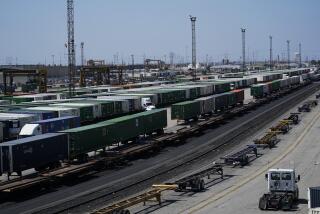As in Old West, Railroad Cop Stays on Track of Trouble
- Share via
FULLERTON — Carrying gloves and a police scanner, Rudy Sanchez walked gingerly into the darkness, glaring at the makeshift tent made of blankets near the railroad tracks.
“We cleaned this place out 10 days ago and now they’re back,” he said, referring to the rickety encampment, uninhabited at the moment. “Now I’ll have to call the state police again.”
Sanchez, 61, was a cop on the beat--a long, skinny beat. His domain as a railroad cop is 50 miles of track in Orange County owned by the Burlington Northern Santa Fe Railroad.
It is a profession older than California, older than its towns or streets, older than its first sheriffs.
In the 1800s, these gunslinging lawmen arrived with the railroads, protecting the trains and the first outposts of civilization. Armed to the teeth, the “railroad bulls,” as they were known, patrolled the tracks on horseback and rode the trains west to protect the railroad and its passengers from train robbers, bringing law and order to the new frontier.
In 1855, they were first organized under the direction of Allan Pinkerton, for whom the security company later was named. Almost 30 years later, the Santa Fe Railroad created its own police force under the leadership of the gunslinger and lawman Bat Masterson.
Today, Burlington Northern still employs 300 sworn peace officers nationwide, including 25 in Southern California.
While the Old West-style robberies have faded into history, an array of modern crimes has taken their place.
Transients still try to catch rides in empty cars, and vandals destroy railroad signals or put things on tracks. Impatient drivers at railroad crossings or people on foot sometimes lose their deadly gamble that they can outrun the trains.
Sanchez battles it all from an unmarked patrol car equipped with a shotgun, siren and police radio. At least twice a day, he drives the full length of track in his jurisdiction, looking for trouble.
When a train passes, he inspects it for open doors, smoking wheels, dragging debris or other potential problems. Then he radios the engineer with his report.
“419 to 1548 west,” Sanchez said, giving his call numbers and the train’s. “Good roll-by.”
Occasionally, he boards a train to work.
“If I have an engineer complaining about a certain area,” Sanchez said, “I’ll jump on the train with him to see what he sees.”
What an engineer sees is sometimes incredible.
Children play chicken on the tracks, daring each other not to move. They put things on the tracks, for the thrill of seeing them flattened, not knowing that a train wheel’s pinch can send objects flying like bullets.
On a recent patrol, Sanchez found something that could have caused a big problem: an abandoned shopping cart left close enough to the track to break the leg of any railroad worker hanging from a passing train. Later that day, he found an old mattress and a sealed can apparently containing hazardous material.
Later, he encountered two boys walking along the railroad track.
“Get off the tracks!” Sanchez yelled on his car’s loudspeaker. “You two, get over here.”
After lecturing them on the dangers of tangling with trains, Sanchez shook their hands.
“I’m going to treat you like men,” he said. “I’ll take your word that you won’t come back here.”
In his 30 years on the job, Sanchez has issued countless warnings and tickets. And, in extreme cases, he has arrested people.
“We try to have zero tolerance,” he said.
Occasionally, he relies on informants to act as extra lookouts, such as Pete Orzechowski, who lives by the Fullerton tracks.
“We have a lot of people crossing the tracks here,” said Orzechowski, 36. “Sometimes they don’t look each way. I have Rudy’s card, and if I see something out of the ordinary, I call him. When Rudy comes around, I have no problems.”
More to Read
Sign up for Essential California
The most important California stories and recommendations in your inbox every morning.
You may occasionally receive promotional content from the Los Angeles Times.










